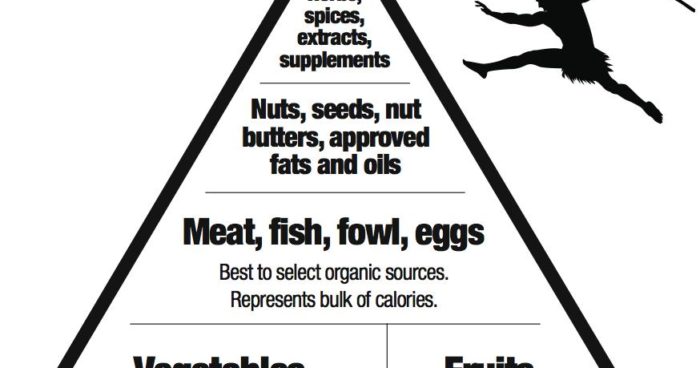At the heart of the Paleo diet is the decision to restrict your food and drink intake to the foods that man ate during the Paleolithic era.
The Paleo diet encourages eating food that we ate prior to agriculture and animal husbandry. For example, foods such as meat, shellfish, eggs, fish, nuts, vegetables, berries, and mushrooms are all part of the diet. In contrast, foods resulting from agriculture or animal husbandry are avoided while on the diet. The types of food to avoid include grains, beans, potatoes, and sugar.
The basic premise behind the Paleolithic Diet is for thousands of years humans and their relatives have managed to survive on a diet of meat, fish, eggs, roots, and leaves. A number of eminent dietitians and nutritionists have observed how changing to a paleolithic diet eliminates the worst aspects of modern eating while still featuring the best of all other dietary theories. The diet only includes foods that were available during the long evolution of man. This means that the paleo diet is hard-coded into our genes. The diet covers all major components including vitamins, protein, carbohydrates, fats, antioxidants, and phytosterols.
The diet is usually referred to as the Paleolithic Diet referring to the Paleolithic or Stone Age era. It is also referred to as the Stone Age Diet, Cave Man Diet, or the Hunter-Gatherer Diet. The paleolithic diet seeks to avoid grains, beans, and potatoes as these foods significantly changed our relationship with food.
These types of food could be stored for longer periods
- Were dense in calories
- Could be easily transported
- Seeds of the plant could later be farmed
While these foods certainly were advantageous for man in many regards, because our genes were never developed with grains, beans, and potatoes, these foods are not as beneficial to us as paleolithic foods are.
Foods to avoid
- Grains– including bread, pasta, noodles
- Beans– including string beans, kidney beans, lentils, peanuts, snow-peas, and peas
- Potatoes
- Dairy products
- Sugar
- Salt
Eat the following
- Meat, chicken, and fish
- Eggs
- Fruit
- Vegetables(especially root vegetables, but definitely not including potatoes or sweet potatoes)
- Nuts, eg. walnuts, brazil nuts, macadamia, almond. Do not eat peanuts (a bean) or cashews (a family of their own)
- Berries– strawberries, blueberries, raspberries, etc.
Try to increase your intake of:
- Root vegetables – carrots, turnips, parsnips, rutabagas, Swedes
- Organ meats – liver and kidneys (I accept that many people find these unpalatable and won’t eat them)
Why you should avoid grains, beans, and potatoes
- Potatoes, beans, and grains are seen as negative for the following reasons:
- They are generally poor sources of vitamins. In particular, they are often lacking in vitamin A, vitamin B, vitamin C, and folic acid.
- These foods are also all toxic in their raw form.
- Although cooking destroys most of the toxins in these foods, it doesn’t destroy of all them. If you fail to cook these foods enough then this could lead to illness, such as gastroenteritis.
- They are rich sources of carbohydrate and once cooked and eaten this can cause something similar to a sugar spike.
- Grains, beans, and potatoes are eaten regularly in modern life. Followers of the paleo diet believe that it is because of these foods that people now feel the need to detox so often.
Things to remember
If you are new to the diet your body may take some time in order to adjust to the changes. The Paleo diet will increase the number of vitamins you take into your body while significantly decreasing the number of toxins in your system. This could cause a shock to your body during the initial stages of the diet. If your body feels strange for a couple of days this is completely natural. It is probably a good idea to ease your way into the diet. Start by just eating a paleo diet breakfast for the first few days of the diet.
You will want to gradually reduce your carbohydrate intake and not suddenly stop eating carbs as this could make you feel ill if you come off carbs too quickly. After a few days of eating breakfast, then add in a paleo meal for lunch. After a few more days of eating paleo food for both breakfast and lunch then move onto the full paleo diet.
Paleo Diet Criticisms
The paleo diet has been criticized by some dieticians for its insistence on reducing dairy intake. Dieters do not have any milk in their diets while eating paleo food so this diet might have a negative effect on the person suffering from bone weakness of osteoporosis. Furthermore, some people can metabolically handle starches and grains just fine, while others cannot (many obese sedentary individuals are likely to have metabolic syndrome and not handle concentrated carbs very well, even natural ones). Also, there is a big difference between natural starches and grain and their refined counterparts.
The Paleo Diet (and may other low carb diets) often go as far as totally rejecting natural grains or carbs such as oatmeal and brown rice. It is certainly advisable to try to minimize the number of refined starches and grains that you eat, but this needs to be tempered by the fact that your dietary needs may be different depending on the overall objectives you have for dieting in the first place.
Your diet may differ slightly depending on the following factors.
- your metabolic/body type.
- your current body composition (fat or lean).
- your genetic predispositions.
- your current state of health.
- your goals; fat loss, muscle growth, athletic performance.
Conclusion
Despite some of the criticisms surrounding the Paleo Diet, it does still have a beneficial impact on your well-being. There are a number of Paleo Diet success stories. While it can be a challenge to remove some foods from your diet, such as pasta and rice, there are a number of healthy and tasty Paleo Diet recipes to try. The diet will also help you to lose weight provided that you are disciplined enough to not eat lots of carbs, grains, and beans. Obesity is now a major factor in developed nations and the Paleo Diet offers an interesting option for people looking to lose weight.
Further Reading
If you decide that the Paleo Diet is not for you then you might want to consider looking at the Dukan Diet or the best fat burning foods.





